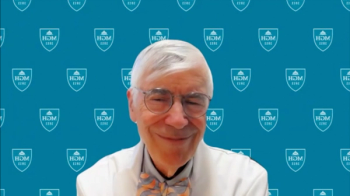
Prostate, Lung Cancers Projected to Be Most Common Cancers Among HIV Population by 2030
The total cancer burden among people living with HIV will decrease from 8150 cases in 2010 to 6690 cases in 2030, and prostate and lung cancers will emerge as the most common types of cancer facing the patient population.
Prostate and
As a result of several decades of efforts to combat the HIV epidemic, most people living with HIV are able to live as long as those without the disease. Although their compromised immune systems leave them more vulnerable to certain cancer diagnoses, the development and uptake of antiretroviral therapy has reduced the risk of certain cancers, such as cervical cancer, that were previously prevalent.
“The cancer burden among US people living with HIV will continue to evolve as cancer incidence rates go up and the size and demographics of the HIV population change over time,” wrote the authors of the study.
Using the National Cancer Institute’s HIV/AIDS Cancer Match Study, the authors determined cancer incidence for people living with HIV and the most common cancer types among the patient population. They modeled trends in cancer incidence rates from 2000 to 2012 to estimate rates for 2013 to 2030 and used the HIV Optimization and Prevention Economics Model to estimate the number of people living with HIV through 2030.
Due to longer life expectancies, the proportion of adults living with HIV aged 65 years and older is expected to climb to 21.4% in 2030, up from 8.5% in 2010.
Since 2000, incidence rates dropped significantly and are expected to continue to drop for Kaposi sarcoma, non-Hodgkin lymphoma, cervical cancer, anal cancer (among men who have sex with men), lung cancer, and Hodgkin lymphoma for all age groups. For those aged 65 years and older, rates of colon cancer also dropped. Meanwhile, prostate cancer rates have increased and are expected to continue increasing.
The total cancer burden among people living with HIV will decrease from 8150 cases in 2010 to 6690 cases in 2030, largely attributable to a significant drop in AIDS-defining cancers. In 2010, the most common cancer types were non-Hodgkin lymphoma, Karposi sarcoma, and lung cancer. By 2020, prostate cancer is expected to be the most common, and in 2030, the most common cancer sites will be prostate (1590 cases) and lung (1030).
The largest decreases will be seen in non-Hodgkin lymphoma and Karposi sarcoma, and the largest increases will be seen in prostate, lung, and liver cancers.
“Although the number of cancer cases diagnosed among people living with HIV is projected to decrease, cancer will remain an important comorbid condition, and continued prevention efforts are needed,” noted the authors. They concluded by underscoring the importance of public health programs focused on cancer prevention, screening, and treatment for the patient population.
Reference
Shiels M, Islam J, Rosenberg P, et al. Projected cancer incidence rates and burden of incident cancer cases in HIV-infected adults in the United States through 2030 [published online May 8, 2018]. Ann Intern Med. doi: 10.7326/M17-2499.
Newsletter
Stay ahead of policy, cost, and value—subscribe to AJMC for expert insights at the intersection of clinical care and health economics.





























































